| Lesson 3 | Database system role in an organization |
| Objective | Differentiate between DBMS types. |
Role of Database System in Organization
If all we need to do is keep information around and prevent it from vanishing when we turn off our computers, we could just simply put in a file on a hard drive. If we were delivering newspapers, we might start out needing only a list of the addresses of where to deliver the papers.
However, if our needs expanded for instance, if we wanted names and payment information as well as delivery addresses, we would begin to see the need for more sophisticated data management. This is where database systems have a role, as they help us organize the information we collect.
The first of three main database architectures is the relational database. The vast majority of databases are of this sort.
Relational databases store data in a row and column model, much like a spreadsheet. The individual columns are called fields, and the rows are called records. The entire collection of rows is usually referred to as a table. A new language, Structured Query Language (SQL and pronounced "see-quil"), was created for working with this relational way of modeling data.
Object-Oriented Databases
The second major type of DBMS is object-oriented. This type stores objects rather than records. The objects it stores are like Java classes, a combination of both data and methods for manipulating that data.
This is very different than the relational approach, where you only store the data, and the manipulation of that data is left to a procedural process. The object-oriented type of DBMS is typically not supported by JDBC.
An object-oriented database is a database management system in which data is represented in the form of objects, as opposed to using a relational model or a hierarchical model. Some characteristics of object-oriented databases include:
- Data is represented using objects: In an object-oriented database, data is stored in the form of objects, which are self-contained units that encapsulate both data and behavior.
- Objects have relationships with other objects: Objects in an object-oriented database can have relationships with other objects, allowing for the creation of complex data structures.
- Objects have inheritance and polymorphism: Objects in an object-oriented database can inherit characteristics from parent objects and can exhibit polymorphism, which means that they can take on different forms depending on their context.
- Supports encapsulation: Encapsulation is a key principle of object-oriented programming, and object-oriented databases support this principle by allowing objects to hide their internal data and behavior from the outside world.
- Persistence: An object-oriented database is designed to store objects in a persistent manner, meaning that the objects are stored permanently and can be retrieved at any time.
Object-Relational Database
The third type of database is a hybrid of the previous two, called an object-relational database. It combines characteristics of both.
Like relational systems, it might support the SQL language, and like object-oriented systems, it allows for the storage of objects. Often, relational database vendors will create extensions to their systems to support storing objects.
Again, JDBC is largely oriented to the relational model. Vendor-specific extensions might allow an application to support these object-oriented features, but, as such, those features are not portable across every DBMS.
The following SlideShow illustrates the various databases and their functions.
The following SlideShow illustrates the various databases and their functions.
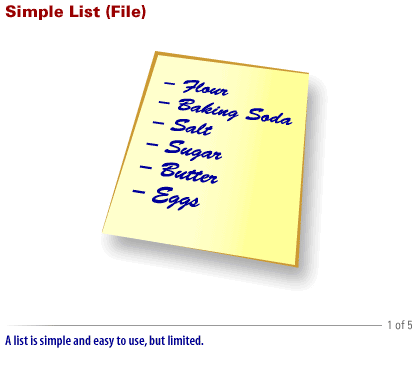
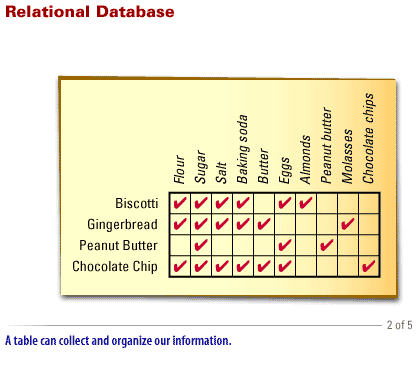
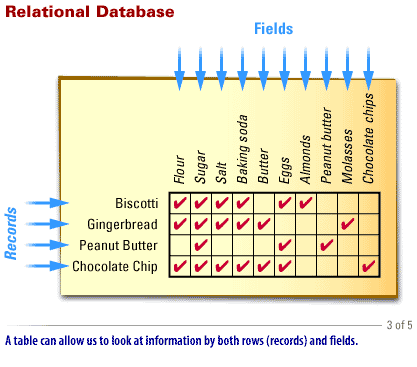
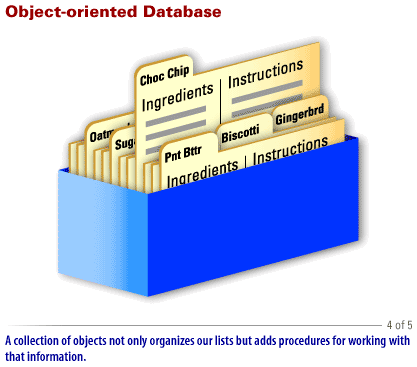
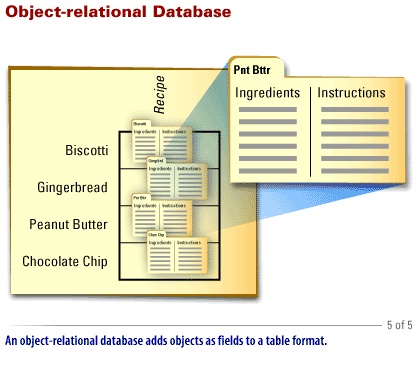
- Simple List File : A list is simple and easy to use, but limited.
- Relational Database 1: A database table can collect and organize our information
- Relational Database 2: A database table can allow us to look at information by both rows (records) and fields.
- Object Oriented Database 1: A collection of objects not only organizes our lists but adds procedures for working with that information.
- Object Oriented Database 2: An object relational database adds objects as fields to a table format
Organizational Database System
In the next lesson, relational databases will be discussed.
In the next lesson, relational databases will be discussed.